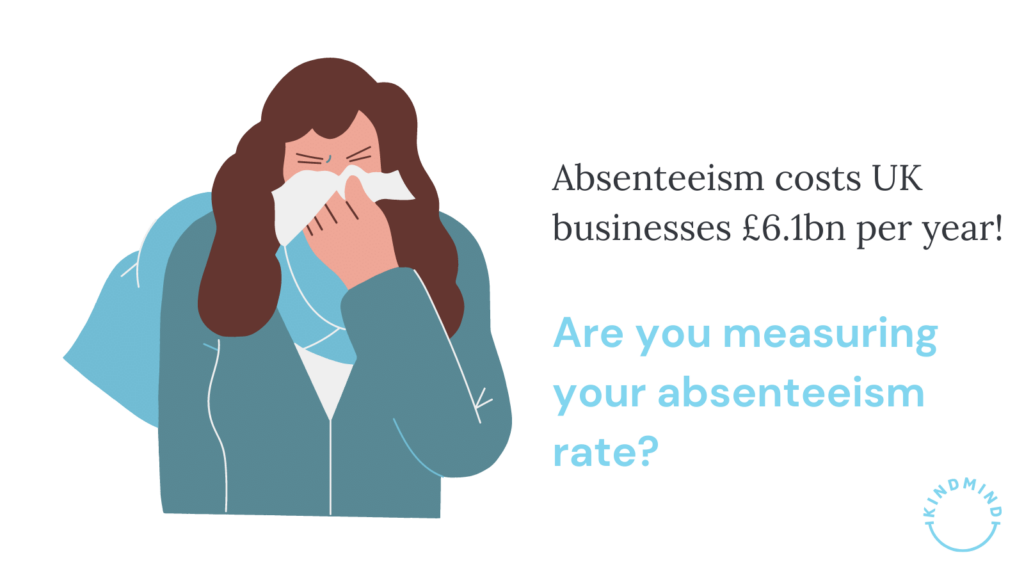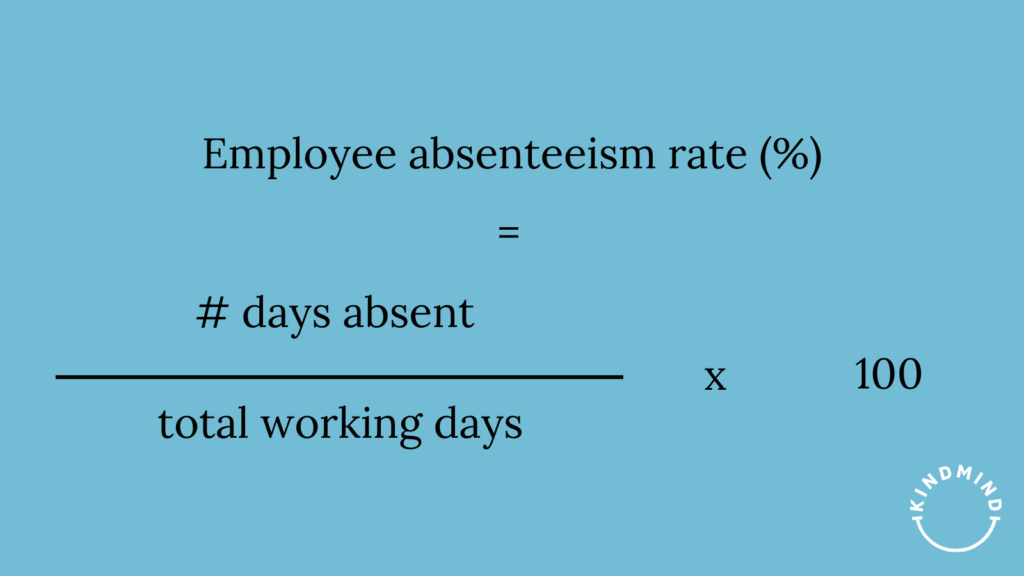You want to know why your employee absenteeism rate is rising, but you aren’t sure where to start. Quantifying it and making a systemic change can be pretty complex, so let’s dive into our Kind Mind guide and get you started.
What is employee absenteeism?
Employee absenteeism is the habitual or occasional absence of an employee from work without an acceptable reason or approval from their employer.
Absenteeism, particularly prolonged or continued absence, can harm a company’s productivity, profitability, and overall performance, resulting in delayed projects, missed deadlines, and reduced morale.
The reasons why employees opt to be absent from work can be a result or combination of;
- Illness or injury
- Personal or family issues
- Transportation issues
- Stress or burnout
- Poor working conditions
- Workplace bullying or harassment
- Low job satisfaction
- Or poor employee experience
Some of these factors will be nothing more than an occasional blip on an employee’s record, but in some cases may cause employees to voluntarily choose to be absent from work. On more rare occasions, they may choose to be absent for extended periods. This is where the real problem starts for business owners because reduced engagement impacts other employees and the business in far more reaching ways.
For this reason, employers often track and monitor employee absenteeism as part of their employee performance management and attendance policies.

Why measure employee absenteeism?
Measuring employee absenteeism can be necessary for a variety of reasons, including:
- Identifying patterns – By tracking employee absenteeism, employers can identify any patterns or trends affecting their workforce, such as high absenteeism rates during certain days of the week, seasons, or among specific departments.
- Managing productivity – Absent employees can cause delays in projects and services. Understanding who, when and how this impacts your workforce can help you refine and streamline processes to account for occasional absences and relook at staffing where the problem continues.
- Reducing costs – Absenteeism can be costly for employers, as they may have to pay for temporary staff or overtime to cover absent employees. In the UK, that cost currently stands at £6.1bn per year! By monitoring absenteeism, employers can identify areas where they can reduce costs and improve their bottom line.
- Improving employee satisfaction – Frequent or excessive absences can create additional workloads for other employees, leading to resentment and decreased morale. By addressing absenteeism, employers can improve employee satisfaction and reduce turnover rates.
- Understanding wellness factors – This is often an overlooked factor in absenteeism, but how your employee is physically and emotionally coping is a huge factor in their quality of work and desire to be at work. By accounting for why an employee is absent and how often, you can establish if your employee healthcare options are robust enough and how you can change an employee’s experience within your organisation.
- Ensuring compliance – Employers may be required to comply with certain laws and regulations related to employee attendance and leave, such as the Family and Medical Leave Act (FMLA) in the US or what we call Holiday entitlement, Sick leave and Compassionate leave here in the UK. Monitoring absenteeism can help employers to ensure compliance with these regulations and avoid legal issues.
Let’s take a look at how to measure absences across your workforce.
How to measure your employee absenteeism
There are several ways to measure employee absenteeism, depending on the size and complexity of your organisation. We’ve put together a list to help you get started.
Manual tracking – keeping a log or spreadsheet to track employee absences.
You can record the date of the absence, the reason for the absence, and the number of hours missed.
This method is simple and cost-effective, but it can be time-consuming and prone to errors, especially in larger organisations where many people have access to a shared file.
Time and attendance software
This type of software can automate the tracking of employee absences and may include features such as leave requests, time-off accruals, and real-time reporting.
This method is more efficient and accurate than manual tracking but costs money.
Here are some examples of time and attendance tracking software:
Surveys
You can conduct surveys to gather information about employee absences, such as why employees are absent, how often they are absent, and how they feel about the company’s attendance policies.
This method can provide qualitative data that complements quantitative data from other tracking methods.
HR analytics
Advanced analytics tools can help you analyse large amounts of data on employee absenteeism and identify patterns and trends that may affect your organisation.
This method can provide valuable insights to inform your attendance policies and strategies.
Regardless of your chosen method(s), it’s crucial to establish clear policies and procedures for tracking and managing employee absenteeism and to communicate these policies to your employees. This can help to reduce absenteeism rates and improve overall productivity and morale in your organisation.
Is there an absenteeism formula?
Yes, an absenteeism formula can be used to calculate the absence rates in your business.

The formula is:
Absenteeism Rate = (Number of Absent Days ÷ Total Number of Work Days) × 100
To use this formula, you need to know the total number of work days for a given period (such as a month or a year) and the number of days employees were absent.
For example, if there were 20 work days in a month and employees were absent for a total of 4 days during that month, the absenteeism rate would be:
Absenteeism Rate = (4 ÷ 20) × 100 = 20%
This means that, on average, your employees were absent for 20% of the work days in that month.
Remember that this formula provides a simple measure of absenteeism but doesn’t explain why employees are absent. So you need to create a system of measure that captures not just the data and rate of absence but also highlights causes.
How often should you measure employee absenteeism?
The frequency with which you should measure employee absenteeism depends on several factors, such as the size and complexity of your organisation, the nature of your workforce, and the goals you are trying to achieve.
We believe there are three opportunities to take reasonable points of measure.
- Monthly and quarterly – Measuring employee absenteeism at regular intervals, such as monthly or quarterly, can help you to identify trends and patterns over time. This can be particularly useful if you are trying to implement new policies or interventions to reduce absenteeism.
- Real-time monitoring – This can help you to respond quickly to any issues that arise, such as a sudden increase in absenteeism in a particular department or among a particular group of employees. This can help you to take proactive steps to address the underlying causes of absenteeism before they become more serious.
- Annual evaluations and 1-to-1s – Conducting an annual assessment of absenteeism can help you assess your progress over a year and make any necessary adjustments to your attendance policies or interventions. This can also help you to communicate your expectations and goals to your employees in 1-to-1s.
Ultimately, you need to decide the combination of measurements you want to record and how frequently it makes sense to record them.
What is a good employee absenteeism benchmark?
Employee absenteeism benchmarks can vary depending on the industry, the organisation’s size, and the work’s nature. However, the average absenteeism rate in the UK was around 4.6 days (2.2%) per year per employee in 2021, according to the Office for National Statistics (ONS). 1.9 days less than the US. This figure is thought to be 0.4% higher than pre-Pandemic figures, so we would expect some adjustments over the next few years.
Similar to the US, some industries in the UK may experience higher rates of absenteeism than others. For example, industries with high physical demands, such as construction or healthcare, may have higher absenteeism rates due to work-related injuries or illnesses. Just as high-pressure sales and banking can cause absences due to stress or burnout.
While the national average can be a starting point for benchmarking employee absenteeism, you must establish benchmarks based on your specific circumstances and industry. It’s also important to track absenteeism over time, identify any trends or patterns that may need to be addressed, and take steps to create a healthy and supportive work environment that encourages attendance and reduces absenteeism.
We consider aiming for 1.8% to 2.2% as a good benchmark.
Related employee absenteeism KPIs
In addition to the absenteeism rate, you should track several related Key Performance Indicators (KPIs) to gain a complete picture of employee absenteeism. Here are a few examples:
- Frequency rate – This measures the number of absences per employee during a specific period. This can be useful for identifying employees with high absences, even if they only miss a few work days each time they are absent.
- Duration rate – This measures the number of days lost to absenteeism during a specific period. This can be useful for identifying employees who are absent for long periods, which can significantly impact productivity and morale.
- Lost time rate – This measures the number of work hours lost due to absenteeism and can help identify the financial impact of absenteeism on your business.
- Absence reasons – Tracking employee absences can help organisations identify absenteeism patterns and underlying causes, such as high-stress levels or a lack of work-life balance.
Ok, so now we know how to track absenteeism, let’s look at how to reduce it.
How to start reducing your employee absenteeism rate
Reducing your employee absenteeism rates requires a multi-faceted approach that addresses the underlying causes of the problem. Here are some steps we recommend that will help.
- Identify the root causes – Analyse to determine the reasons for employee absence. This can include reviewing absence records, surveying employees, and gathering manager feedback.
- Communicate expectations – Attendance guidance will help employees understand the impact of absenteeism on the organisation.
- Encourage an open culture where you talk about issues before they lead to absences – Many of the reasons why employees go absent can be fixed in-house. For example, health and safety problems that cause repeated injuries can be fixed, as can stress around workloads. Encouraging open dialogue around job satisfaction and task procedure can help you establish better policies and streamlined workflows.
- Provide employee support – Create support packages and resources to address the root causes of absenteeism, such as flexible work arrangements, mental health support, and stress management programs. Encourage employees to take advantage of these resources and ensure they understand that absenteeism is not a sign of weakness or failure.
- Improve work conditions – Make changes to improve work conditions, such as reducing workload or implementing policies that promote work-life balance. This can help reduce stress and burnout, leading to improved attendance.
- Track and monitor progress – Monitor your absenteeism rate regularly to identify trends and patterns. Use this information to refine your approach and identify areas for improvement.
Improving employee absenteeism takes time and effort, but proactively addressing the root causes can create a healthier and more productive work environment for your employees.
Good luck.
Looking for more guides on HR benchmarks? Read our latest articles here.






